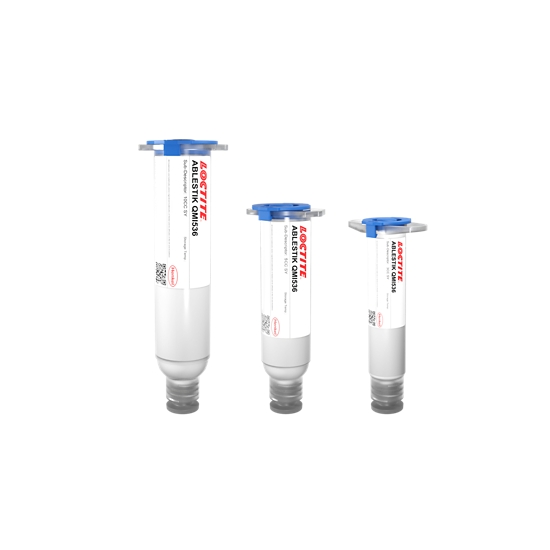LOCTITE ABLESTIK QMI536
- Bismaleimide resin
- One component
- Excellent dielectric properties
Product Description
LOCTITE® ABLESTIK QMI536 is a Fluoropolymer filled non-conductive adhesive for attachment of integrated circuits and components to advanced substrates, including PBGAs, CSPs, array packages, and stacked die. This material is hydrophobic and stable at high temperatures. These features produce a void-free bond line with excellent interfacial adhesive strength to a wide variety of organic and metal surfaces, including solder mask, BT, FR, polyimide, and Au. The adhesive also has excellent dielectric properties.
LOCTITE ABLESTIK QMI536 can be cured in a conventional oven, on a snap cure oven, or utilize SkipCure processing on a die bonder or wire bonder. The material is formulated to produce cure onset below 100°C. This can reduce or eliminate the need to pre-dry organic substrates prior to the die attach process.
LOCTITE ABLESTIK QMI536 has excellent rheology and flows easily under shear stresses such as those present during die bonding. Therefore, bondforces used with other adhesives which produce a certain bondline thickness, may result in thinner bondlines with LOCTITE ABLESTIK QMI536. Optimization of die bonding parameters is strongly recommended, to consistently meet target bondline thickness.
Cure Schedule
- ≥10 @ 150°C (SkipCure)
- 15 minutes @ 150 °C (Convection Box Oven)
Technical Specifications
| General Properties | |
| Pot Life Pot Life Pot life is the amount of time it takes for the viscosity of a material to double (or quadruple for lower viscosity materials) in room temperature after a material is mixed. It is closely related to work life but it is not application dependent, less precise and more of a general indication of how fast a system is going to cure. | 24 hours |
| Specific Gravity Specific Gravity Specific gravity (SG) is the ratio of the density of a substance to the density of a reference substance; equivalently, it is the ratio of the mass of a substance to the mass of a reference substance for the same given volume. For liquids, the reference substance is almost always water (1), while for gases, it is air (1.18) at room temperature. Specific gravity is unitless. | 1.26 |
| Thermal Properties | |
| Glass Transition Temperature (Tg) Glass Transition Temperature (Tg) The glass transition temperature for organic adhesives is a temperature region where the polymers change from glassy and brittle to soft and rubbery. Increasing the temperature further continues the softening process as the viscosity drops too. Temperatures between the glass transition temperature and below the decomposition point of the adhesive are the best region for bonding. The glass-transition temperature Tg of a material characterizes the range of temperatures over which this glass transition occurs. | -31 °C |
| Thermal Conductivity Thermal Conductivity Thermal conductivity describes the ability of a material to conduct heat. It is required by power packages in order to dissipate heat and maintain stable electrical performance. Thermal conductivity units are [W/(m K)] in the SI system and [Btu/(hr ft °F)] in the Imperial system. | 0.3 W/m.K |
| Physical Properties | |
| Thixotropic index Thixotropic index Thixotropic Index is a ratio of a material s viscosity at two different speeds in Ambient temperature, generally different by a factor of ten. A thixotropic material s viscosity will decrease as agitation or pressure is increased. It indicates the capability of a material to hold its shape. Mayonnaise is a great example of this. It holds its shape very well, but when a shear stress is applied, the material easily spreads. It helps in choosing a material in accordance to the application, dispense method and viscosity of a material. | 5.7 |
| Viscosity Viscosity Viscosity is a measurement of a fluid’s resistance to flow. Viscosity is commonly measured in centiPoise (cP). One cP is defined as the viscosity of water and all other viscosities are derived from this base. MPa is another common unit with a 1:1 conversion to cP. A product like honey would have a much higher viscosity -around 10,000 cPs- compared to water. As a result, honey would flow much slower out of a tipped glass than water would. The viscosity of a material can be decreased with an increase in temperature in order to better suit an application | 20,000 mPa.s |



